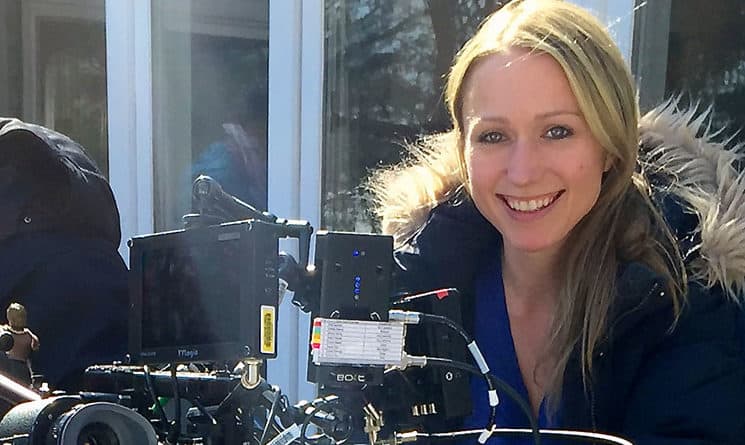When the crew for the film “The Last Poker Game” came to shoot in Newburyport, Mass. last fall, they had a local on their team: production designer and Stratham native Bridget Keefe. Keefe never guessed that she would be introducing producers from New York to her favorite local restaurants, or furnishing sets with props from the Oldies Marketplace in Newburyport. But she always knew she would work in the film industry.
“I always dreamed of living in L.A. and working on movie sets,” says Keefe, who graduated from Exeter High School in 2000. Growing up, she wasn’t aware of the full spectrum of jobs in the film industry, so she figured she would be an actor. When she auditioned as an extra after college, however, she quickly learned that she didn’t like being in front of the camera.
“But I really loved the vibe and the atmosphere on set,” she says.
Before she made it on set, though, Keefe spent a few years in a prestigious, but unsatisfying, corporate marketing job in New York City. Her lucky break came when she left the job and moved back to New Hampshire. While out at lunch with some friends, Keefe discovered the movie “The Box” was shooting nearby in Massachusetts. They went to the set and asked a lot of questions — behavior she now admits must have been annoying. Keefe met Cameron Diaz, made a little money as an extra, and became more involved behind the scenes. The crew offered her a job — she’d travel to Rhode Island and be a set dresser for their next project, “Tell Tale.”
Keefe says she has always had an eye for design, but the learning curve was steep. “The funniest thing looking back is my first movie, ‘Tell Tale,’ because I had no idea what I was doing,” she says. She was working 14-hour days with a two and a half hour commute from her mother’s house in New Hampshire.
“I was always in the way of the camera,” she says. “Every day I was doing something wrong and being corrected.” But she stuck with it, and she was grandfathered into a regional film-industry union, IATSE 481. Her new career in film production design was off and running.
“Your job as a production designer is to control the look and the tone and the feel of the movie.” — Bridget Keefe
At first, Keefe says, she couldn’t even wire a lamp, but she has acquired a diverse array of skills as a set dresser and production designer. She’s learned how to hang million-dollar artwork, how to make rooms feel inviting, and how to carry a couch up flights of stairs. “I’ve become a much stronger person physically and mentally because of this job,” she says.
Keefe works throughout New England but is most frequently in Massachusetts, which offers a generous tax incentive program to attract film productions. According to the Mass. Film Office, “The Last Poker Game,” one of Keefe’s most recent productions, was one of 26 films or TV series to be shot in the state in 2015.
“The Last Poker Game” is a drama that focuses on the friendship between two elderly men, played by Martin Landau and Paul Sorvino. Much of the film was shot at Avita, an assisted-living facility near Anna Jacques Hospital. There was just one problem: the facility had just opened, and when shooting started, Avita had only a handful of residents. The bedroom where Sorvino’s character had lived for a decade was totally empty.
To make the spaces look authentic and full, Keefe and her team drew on elements from the actors’ real lives. For example, Keefe learned that, as a young man, Sorvino dreamed of becoming an opera singer, so her team found an old record player and various opera records, along with some Italian flags to reflect his heritage. To find these treasures, Keefe and her team combed her favorite local shops, including the Oldies Marketplace and Leeward Light Thrift Store in Salisbury. Keefe says she’s always a little nervous about how stars will react to the spaces she designs, but Sorvino “really appreciated these personalized touches we brought to his apartment set,” she says.
Production designers do far more than just shop for fun antiques, though.
“Your job as a production designer is to control the look and the tone and the feel of the movie,” Keefe says. For this film, she had a team of six to eight people, including set dressers, art buyers, production assistants, and a props person. Shooting took about six weeks and wrapped up in December; a release date hasn’t been announced.
“The Last Poker Game” had a relatively small budget; Keefe says that for larger-budget films, an entire crew of people might spend months sourcing the perfect items for a set. Smaller projects offer “a more intimate experience, because you’re responsible for a lot more of the details.”
Eight years into her career in production design, Keefe doesn’t regret trading her Manhattan suits for jeans and a tool belt. “It’s a totally different lifestyle,” Keefe says, “and it’s exactly where I’m supposed to be.”

